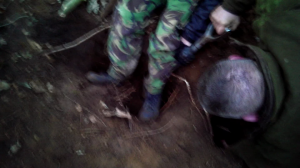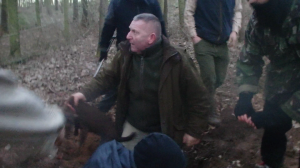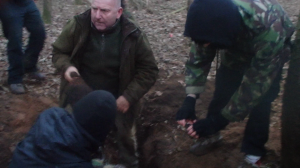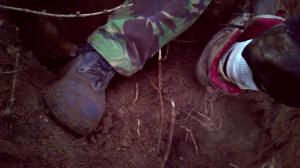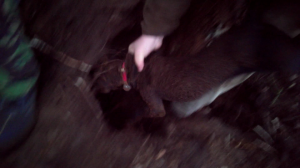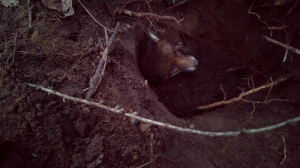BOOKS: Planetary Consciousness and the Tears of the World—A Review of Carolyn Baker’s Collapsing Consciously
One can open this 173-page book just about anywhere, read a few pages, and have something to contemplate and meditate for the rest of the day, or several days, or a lifetime. The book is divided into 2 parts: “Collapse, Transition, the Great Turning” and “Transformative Truths for Turbulent Times.” The first part, about 2/3 of the book, works as a kind of Zen-slap to wake up the disconnected, mesmerized and unfocussed to the terrible predations we have made on Planet Earth these past 200 years of the Industrial Revolution and 100 years of Corporate-Federal Reserve-Media-Military-Academic State-ism. The last 63 pages consist of pertinent, sometimes glittering, quotes from Ms. Baker’s wide and varied reading in Jung and psychology, the Arts, environment and political matters—and her thoughts in response to those quotes and insights. This is a book with “designs” on the reader: the author intends to warn, inform, and transform.
The book’s author-profile states that Dr. Baker is a “former psychotherapist and professor of psychology and history. She is nationally renowned for her writing and workshops on emotional resilience in challenging times…. Her books include Navigating the Coming Chaos: A Handbook for Inner Transition and “Sacred Demise: Walking the Spiritual Path of Industrial Civilization’s Collapse. Her website is SpeakingTruth to Power, at www.carolynbaker.net.”
 I confess that I have not read Ms. Baker’s previous books, but I have, in recent years, profitably read her articles appearing at some of the best progressive websites as well as her own site. In spite of her obvious erudition, Ms. Baker has a way of “telling it like it is,” without frills–a wise woman talking frankly to those wise enough to listen.
I confess that I have not read Ms. Baker’s previous books, but I have, in recent years, profitably read her articles appearing at some of the best progressive websites as well as her own site. In spite of her obvious erudition, Ms. Baker has a way of “telling it like it is,” without frills–a wise woman talking frankly to those wise enough to listen.
“Our inexorable reality in this moment is one of contraction, decline, and demise. Industrial civilization is collapsing.” Thus, with punches un-pulled, she launches us outward, upward and within from the get-go. There, in the intro, we also learn a little about her recent battles: “As I send this book to publication, I have recently confronted a personal collapse in the form of a health challenge. I have been humbled and constrained by a recurrence of breast cancer. And although my treatment is complete and my prognosis very good… I recognize it as yet another spiritual rite of passage….
Rites of passage, of course, are not easy to navigate… and impossible to circumvent. Fact is humankind in 2014, decades after those prophetic masters’—Orwell’s and Huxley’s—dark premonitions… has succeeded in trumping those foreboding visions. With Ms. Baker’s book and the daily headlines, it’s easy to catalogue the innumerable crises we face: Polar Vortex? What the hell is that? Is there a tie-in with Global Climate Change? What about all this methane gas being released from Siberia’s permafrost melting? What about “Peak Oil”? What about the plume of radiation emanating from the crippled Fukushima nuclear plants? Why hasn’t something been done about the hole in the ozone that I first read about some 30 years ago? When will the endless “peace process” end and we simply have Peace in the Middle East and elsewhere? Are we incapable of transcending our warrior past, our reptilian brain, our genetic, social and historical limitations?
These are some of the questions Ms. Baker would have us examine, and, always, she urges us to know ourselves, to understand deeply. With her background in psychology—especially Jungian–, she exhorts us to know our “Shadow” side—to embrace even the darkness. Collapse consciously! That’s the ticket. There’s hell to pay. We’ve messed up our only home and things will get a lot worse… before they… if they ever get better!
But we can conceive the multitude of challenges we face as a spiritual journey, too.
Let me be clear: this is no namby-pamby “New Age” book where everything turns out honky-dory if only we chant “Om” while the Earth gets fracked beneath our rising kundalini’s. More than once, Ms. Baker enjoins the human race to “grow up!” We are forewarned in the intro: “I am drawn to the perennial wisdom of the towering giants of poetry, story, art, music, and literature. They never have and never will offer us happy stories with happy endings. Rather, they offer us life—in all of its angst, beauty, ire, terror, joy, celebration, ecstasy and demise.” And, again, in her first chapter: “Preparing logistically or emotionally for the collapse of life as we have known it since arriving on this planet is not supposed to be fun.” And, in a later chapter: “Unless we include the possibility of death in our presentation, we aren’t really preparing.” Yes, this is also a book about learning how to die, how to face death.
Like Chris Hedges in Empire of Illusion, Ms. Baker has no patience with our cult of “positive thinking.” I think that cult is a legitimate target of real thinkers (who acknowledge the Shadow), but, occasionally, Ms. Baker over-shoots her mark, conflating all New Agers with Dale Carnegie-type positivists. Of course, “New Age” goes back some 40 years, and is feeling its knees. But much of it was about much more than positive thinking and Ms. Baker knows that in her bones every time she relates a bit of Eastern wisdom, or quotes Lao Tzu or Buddha.
This is a book about becoming whole again; reaching deep within, not to overcome the Shadow, but to integrate and join forces with it. It’s a book about developing a planetary consciousness to confront the global muck we’ve created. It’s a book about making connections—within ourselves, and with others. Ms. Baker quotes Francis Weller, author of Entering the Healing Ground: Grief, Ritual, and the Soul of the World:
“Our sorrow eases the hardened places within us, allowing them to open again and freeing us to once more feel our kinship with the living presence around us. This is deep activism, soul activism that actually encourages us to connect with the tears of the world.”
Gary Corseri has taught in US public schools and prisons, and at US and Japanese universities. His dramas have been produced on Atlanta-PBS; he has performed his work at the Carter Presidential Library; and his prose and poems have appeared at hundreds of publications/websites worldwide, including, The Greanville Post, Redbook, OpEdNews, Village Voice, The New York Times, Smirking Chimp, L.A./Hollywood Progressive, Countercurrents, BraveNewWorld.in. Contact: Gary_Corseri@comcast.net.











